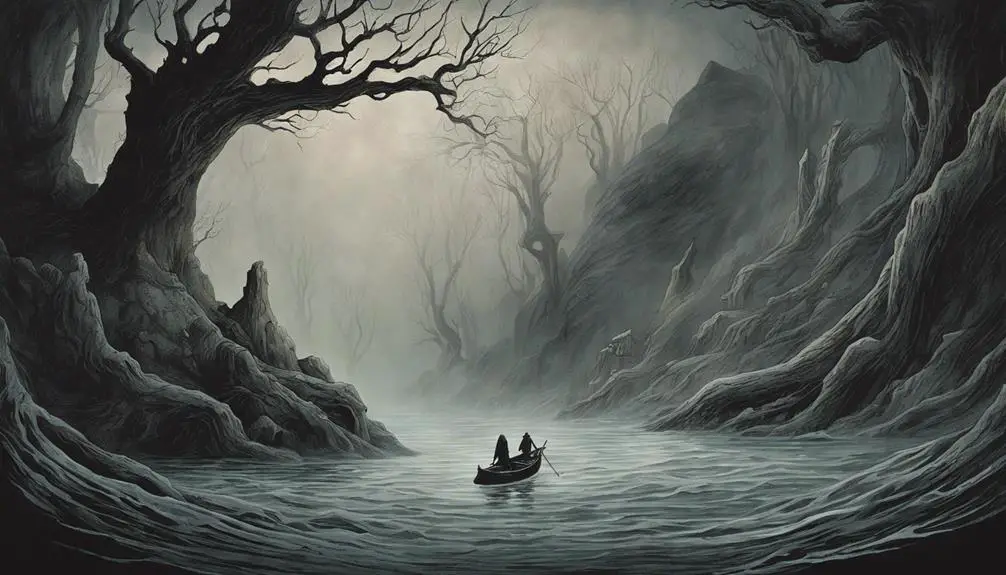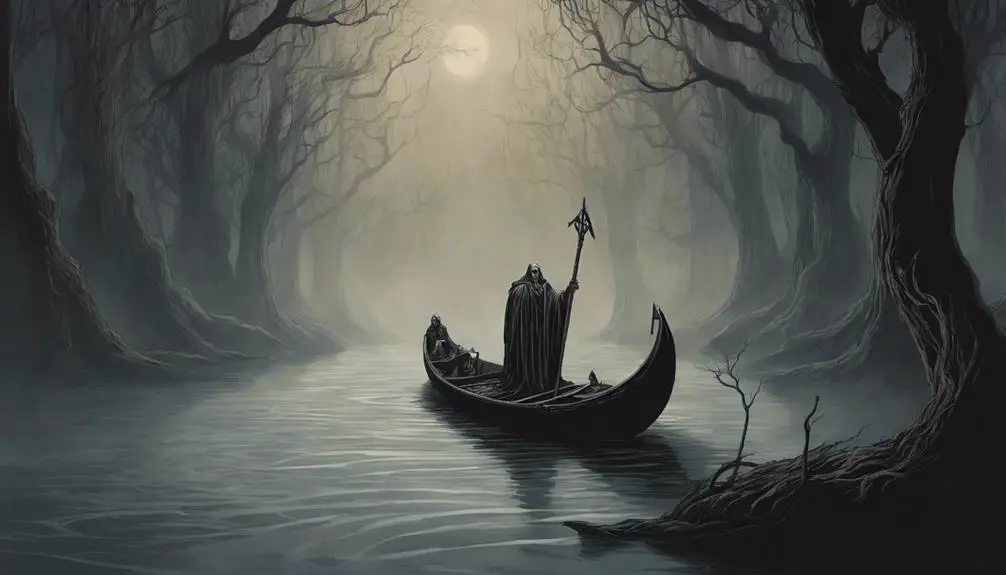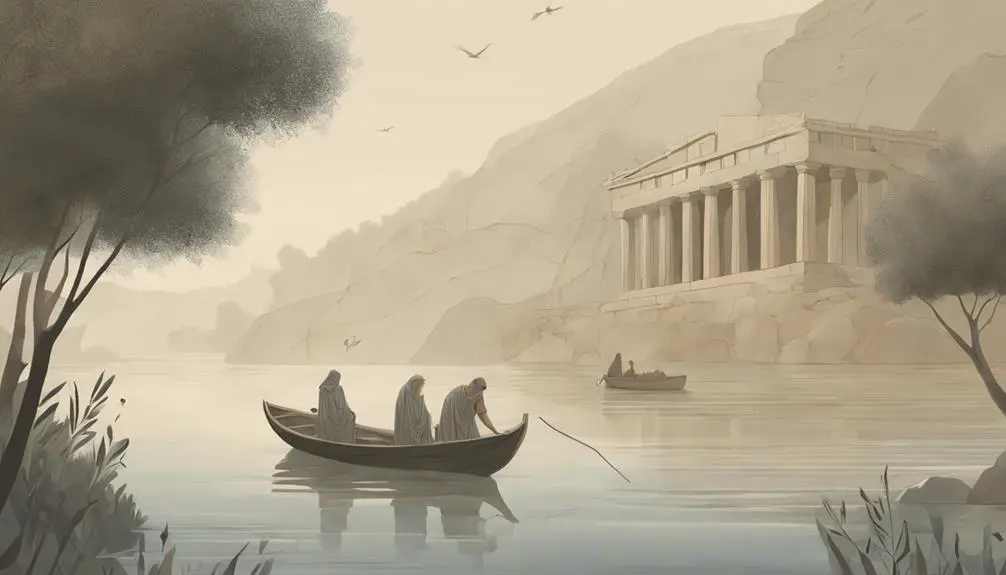Learn how the River Styx and biblical references intertwine, uncovering hidden connections in ancient beliefs about the afterlife.

River Styx in the Bible
Just as the ancient Greeks navigated the murky waters of the River Styx to reach the afterlife, you might find yourself traversing the complex landscape of biblical references to understand its connections to such mythological elements.
The River Styx, a staple in Greek mythology, symbolizes the boundary between Earth and the Underworld, yet its presence or its metaphorical counterparts in the Bible aren't as straightforward as one might expect.
As you explore these ancient texts, consider how the concept of an afterlife river might weave through different cultures and what this suggests about our collective imaginations.
This journey might reveal unexpected bridges between mythologies and religious teachings, offering fresh perspectives on familiar tales.
Key Takeaways
- The River Styx does not appear in the Bible, reflecting distinct mythological and theological traditions.
- Biblical afterlife concepts focus on resurrection and heavenly realms, differing from Greek underworld imagery.
- Greek mythology's River Styx symbolizes death's transition, contrasting with the Bible's emphasis on hope and morality.
- Comparing the Styx to biblical narratives highlights diverse cultural understandings of the afterlife and ethics.
Origins of the River Styx

The River Styx, deeply embedded in Greek mythology, doesn't originate from the Judeo-Christian Bible, but its mythical essence has permeated various aspects of ancient and modern cultures. You'll find that its origins, shrouded in mystery and speculation, have spurred various geographical theories and mythological adaptations over the centuries. Scholars have attempted to pinpoint its existence, suggesting that the mythical river could be inspired by real rivers flowing through Greece or nearby regions, thus blending tangible geography with the intangible myth.
Mythological adaptations have been particularly fascinating, showcasing how the Styx has been woven into narratives far beyond its initial Greek mythos. These adaptations often reflect cultural beliefs about the afterlife, morality, and the supernatural, illustrating the river's role as a boundary between the worlds of the living and the dead. As you delve deeper into the origins of the River Styx, you encounter a rich tapestry of stories and interpretations that have evolved over time, influenced by geographical discoveries and the creative reimagining of ancient texts. This exploration reveals how the Styx, while not biblically derived, has become a symbol of the crossing over into the unknown that resonates across cultures.
The River Styx in Greek Mythology

In Greek mythology, River Styx serves as the ultimate boundary between the earthly realm and the underworld, symbolizing a transition that every soul must navigate after death. This river not only demarcates the living from the dead but also plays a critical role in the mythology's cosmology, setting the stage for numerous tales involving gods and mortals alike.
Central to the River Styx's narrative is Charon's duty. As the ferryman, Charon is responsible for transporting souls across this watery divide, provided they have the necessary fare. This duty underscores the river's function as a threshold that must be crossed, further emphasizing its importance in the journey of the soul.
Mythological creatures associated with the River Styx further enrich its lore, each adding a layer to the river's ominous reputation. Below is a table detailing some of these entities:
Creature |
Role |
Association with Styx |
|---|---|---|
Charon |
Ferryman |
Transports souls across the river |
Cerberus |
Guardian |
Guards the entrance to the underworld |
Erinyes |
Punishers |
Enforce oaths sworn upon the Styx |
Nymphs |
Spirits |
Personify the river's natural aspects |
Hades |
God of the Underworld |
Rules the domain beyond the Styx |
Through its incorporation of Charon's duty and its roster of mythological creatures, the River Styx stands as a significant symbol in Greek mythology, representing the inevitable transition from life to death.
Biblical References to the Afterlife

While Greek mythology presents the River Styx as a boundary between life and death, biblical texts offer a complex view of the afterlife that differs significantly in concept and imagery. You'll discover that the Bible, rather than depicting a singular river marking the passage to the underworld, paints a vivid picture of an afterlife grounded in resurrection beliefs and heavenly descriptions.
In the Hebrew Bible, or Old Testament, references to the afterlife are sparse and somewhat ambiguous, focusing more on Sheol, a shadowy place of the dead, rather than a detailed afterlife scenario. However, the concept evolves significantly by the time of the New Testament, where the afterlife is articulated with greater clarity and detail. Here, resurrection beliefs take center stage, promising believers a physical resurrection and eternal life. This resurrection isn't just a return to life but a transformation into a glorified existence in heaven, a realm described with grand imagery and profound peace.
Heavenly descriptions in the New Testament, such as those found in the Book of Revelation, contrast sharply with the gloomy, somber tones associated with the River Styx. These descriptions offer a vision of the afterlife that's radiant and hopeful, emphasizing a restored creation where suffering and death have no place.
Cultural Impact of the River Styx

Transcending its mythological origins, the River Styx has profoundly influenced various cultural, artistic, and philosophical domains, embedding itself into the collective consciousness as a symbol of the ultimate transition. This impact is evident through:
- Literature and Poetry: From Dante's 'Inferno' to modern novels, Styx symbolism serves as a narrative mechanism to explore themes of death, the afterlife, and the human soul's journey, offering a rich tapestry for storytelling.
- Music and Performance Arts: Bands and composers have drawn on the evocative imagery of the Styx to convey themes of finality and separation. Operas and ballets reinterpret its myth, providing audiences with a visceral experience of its symbolic meaning.
- Philosophical Discourses: The Styx has been a point of reference in discussions about mortality, ethics, and the metaphysical journey of the soul, challenging thinkers to explore the boundaries between life and death.
- Visual Arts: Artists have depicted the Styx in various forms, using its symbolism to question human existence, fate, and the nature of transition, allowing for a visual exploration of its themes.
These manifestations of Styx symbolism in modern interpretations underscore its enduring relevance, providing a bridge between ancient mythology and contemporary cultural expressions.
Comparative Mythology and the Bible

Exploring the cultural impact of the River Styx prepares us to examine how comparative mythology and the Bible intersect, offering insights into shared motifs and divergent narratives in religious texts. You'll find that both ancient Greek myths and biblical stories often revolve around themes of morality, divine intervention, and the afterlife. Specifically, the concept of the River Styx and its role as a boundary between the living and the dead echoes through the Bible's discussions of the afterlife, albeit in a different context.
Delving deeper, the Hades parallels become apparent. In Greek mythology, Hades rules over the dead, a concept not unlike the biblical Sheol or Hades, where souls reside post-mortem. However, the nature of these realms and their rulers diverges significantly, reflecting each tradition's unique theological and ethical perspectives.
Moreover, the notion of divine punishments for broken oaths, as symbolized by the River Styx, finds its counterpart in the Bible through stories where vows to God carry profound consequences. These narratives emphasize the sacredness of one's word to the divine, illustrating a shared recognition of the power of oaths across cultures, yet they articulate distinct understandings of divine justice and morality.
Lessons From the River Styx

The River Styx, as a mythological boundary between life and death, offers valuable lessons on the human understanding of morality and the afterlife. This ancient concept encourages you to explore the depths of moral interpretations and ethical dilemmas, revealing how ancient myths continue to shape our ethical landscapes.
- Moral Accountability: The journey across the River Styx symbolizes the ultimate accountability for one's actions. It prompts a reflection on how your deeds in life impact your fate in the afterlife, urging a conscientious approach to ethical decision-making.
- Eternal Consequences: The myth underscores the belief in consequences that transcend mortal existence. This aspect teaches the importance of considering the long-term impacts of your actions, not just the immediate benefits or consequences.
- Ethical Dilemmas: Navigating the River Styx can be seen as a metaphor for navigating life's ethical dilemmas. It highlights the complexity of moral decision-making and the need for wisdom and discernment.
- Reflection on Mortality: The mythological river serves as a reminder of mortality and the inevitability of death. It encourages a thoughtful examination of how your life and actions contribute to a legacy that endures beyond death.
Frequently Asked Questions
How Do Modern Interpretations of the River Styx Differ From Its Ancient Descriptions, Especially in Contemporary Literature and Media?
You'll find that modern interpretations of the River Styx have evolved significantly from its ancient roots, particularly in contemporary literature and media.
The term's etymology often serves as a deep well for creative exploration, weaving into narratives that stretch far beyond its mythological origins.
Video game adaptations, for instance, reimagine the Styx as more than a mere boundary; it becomes a character, a challenge, or a pivotal plot point, showcasing its enduring legacy and adaptability.
Are There Any Real-World Geographical Locations Believed by Some Cultures or Scholars to Be Connected to or Inspired by the Mythological River Styx?
You'll find that geographical explorations and cultural beliefs have indeed linked real-world locations to the mythological River Styx. Scholars and various cultures see rivers such as the Acheron in Greece as physical manifestations or inspirations of the Styx myth.
This connection stems from ancient descriptions and the river's role in rituals and mythology. Such identifications highlight how deeply mythological narratives can influence perceptions of our natural landscape.
What Are the Ethical and Moral Implications of the River Styx's Role in the Afterlife Across Different Cultures, Especially in Terms of Justice and Redemption?
You'll find that the River Styx's role in the afterlife poses significant ethical questions, especially regarding justice and redemption across cultures.
This mythological boundary between the living and the dead prompts you to consider environmental ethics and cultural appropriation.
How do societies balance respect for nature with beliefs about the afterlife?
Moreover, the idea of a final judgement across cultures challenges you to think about the fairness and universality of moral standards.
How Have Various Art Forms, Outside of Literature—Such as Painting, Music, and Film—Interpreted or Been Influenced by the Concept of the River Styx?
Exploring the River Styx's influence, you'll find it's woven into various art forms, capturing imaginations beyond mere words. Artists, musicians, and filmmakers have dipped their brushes, notes, and lenses into its mythical waters, creating works that mirror its dark allure.
This concept has even rippled into Styx architecture, with designs echoing its somber elegance, and Styx cuisine, where flavors are concocted to evoke its profound symbolism. Each interpretation invites a deeper reflection on life's final passage.
In What Ways Have Psychological Theories or Psychological Interpretations Been Applied to Understand the Symbolism of the River Styx in Human Consciousness and Society's Collective Fears or Hopes About the Afterlife?
You'll find that psychologists have delved into the River Styx's symbolism through dream analysis and consciousness studies. They explore how this mythological river reflects our deep-seated fears and hopes about the afterlife, linking it to our collective unconscious.
Conclusion
In your journey through myth and scripture, you've traversed the shadowy banks of the River Styx, a boundary not just of realms but of understanding. Like Dante at the edge of Inferno, you stand at a confluence where cultures and beliefs merge, revealing that our fascination with the afterlife transcends texts and traditions.
This exploration illuminates our collective yearning for meaning beyond the mortal coil, challenging us to reflect on the ethereal rivers that chart our spiritual landscapes.



Sign up